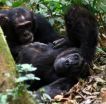(Press-News.org) Researchers from Wits University and the University of Johannesburg in South Africa, together with international scientists announced on Tuesday, 22 January 2012, the discovery of a two million year old fossil fox at the now renowned archaeological site of Malapa in the Cradle of Humankind World Heritage Site.
In an article published in the prestigious journal Transactions of the Royal Society of South Africa, the researchers describe the previously unknown species of fox named Vulpes Skinneri - named in honour of the recently deceased world renowned South African mammalogist and ecologist, Prof. John Skinner of the University of Pretoria.
The site of Malapa has, since its discovery in 2008, yielded one of the most extraordinary fossil assemblages in the African record, including skeletons of a new species of human ancestor named Australopithecus sediba, first described in 2010.
The new fox fossils consist of a mandible and parts of the skeleton and can be distinguished from any living or extinct form of fox known to science based on proportions of its teeth and other aspects of its anatomy.
Dr. Brian Kuhn of Wits' Institute for Human Evolution (IHE) and the School of GeoSciences, an author on the paper and head of the Malapa carnivore studies explains: "It's exciting to see a new fossil fox. The ancestry of foxes is perhaps the most poorly known among African carnivores and to see a potential ancestral form of living foxes is wonderful".
Prof. Lee Berger, also of the IHE and School of GeoSciences, author on the paper and Director of the Malapa project notes: "Malapa continues to reveal this extraordinary record of past life and as important as the human ancestors are from the site, the site's contribution to our understanding of the evolution of modern African mammals through wonderful specimens like this fox is of equal import. Who knows what we will find next?".
The entire team has expressed their privilege in naming the new species after "John Skinner, one of the great names in the study of African mammals and particularly carnivores. We (the authors) think that John would be pleased, and it is fitting that this rare little find would carry his name forever."
INFORMATION:
The authors on the paper are:
Adam Hartstone-Rose 1, Brian F Kuhn 2,3, Shahed Nalla2,4, Lars Werdelin5, Lee R. Berger2,3 (2013): A new species of fox from the Australopithecus sediba type locality, Malapa, South Africa, Transactions of the Royal Society of South Africa, DOI:10.1080/0035919X.2012.748698
1Pennsylvania State University Altoona, 205 Hawthorn, 3000 Ivy Side Park, Altoona, PA 16601
2Institute for Human Evolution, University of the Witwatersrand, Johannesburg, Private Bag 3, Wits 2050, South Africa
3School of GeoSciences, University of the Witwatersrand, Johannesburg, Private Bag 3, Wits 2050, South Africa
4Department of Human Anatomy and Physiology, Faculty of Health Sciences, University of Johannesburg, Johannesburg, South Africa
5Department of Palaeozoology, Swedish Museum of Natural History, Box 50007, SE-10405 Stockholm, Sweden
Previous unknown fox species found
Another new species from Malapa site
2013-01-23
ELSE PRESS RELEASES FROM THIS DATE:
Study: Transparent pricing doesn't curb doctors' use of high-cost hospital imaging tests
2013-01-23
In a study designed to see if doctors who are told the exact price of expensive medical tests like MRIs in advance would order fewer of them, Johns Hopkins researchers got their answer: No.
In a report published online in the Journal of the American College of Radiology, the researchers found that revealing the costs of MRIs and other imaging tests up front had no impact on the number of tests doctors ordered for their hospitalized patients.
"Cost alone does not seem to be the determining factor in deciding to go ahead with an expensive radiographic test," says the ...
Microdosing: Updating its role in developing new medicines
2013-01-23
One of yesterday's most promising new tools for speeding the development of new medicines — "microdosing" — has found niches in that process today, and they include uses unanticipated a decade ago. That topic, an update on microdosing, is the cover story in the current edition of Chemical & Engineering News. C&EN is the weekly newsmagazine of the American Chemical Society, the world's largest scientific society.
C&EN Senior Editor Celia Henry Arnaud explains that microdosing offered promise for helping pharmaceutical companies identify potential failures earlier, before ...
Knobbly knees in competition with fingerprints
2013-01-23
Forget digital fingerprints, iris recognition and voice identification, the next big thing in biometrics could be your knobbly knees. Just as a fingerprints and other body parts are unique to us as individuals and so can be used to prove who we are, so too are our kneecaps. Computer scientist Lior Shamir of Lawrence Technological University in Southfield, Michigan, has now demonstrated how a knee scan could be used to single us out.
The approach based on MRI could be used to quickly register and identify people in a moving queue as they approach passport control at airports ...
Women must do more to reap same positive health outcomes as men, MU research suggests
2013-01-23
COLUMBIA, Mo. — More than one-third of Americans are obese, and these individuals often experience accompanying health issues, such as Type 2 diabetes and cardiovascular problems. In response to the so-called "obesity epidemic," many medical professionals have suggested ways to improve the health outcomes of obese individuals through diet and exercise. Now, research conducted at the University of Missouri suggests certain exercises that benefit obese men may not have the same positive results for obese women. These findings could help health providers and researchers develop ...
Study shows high blood calcium levels may indicate ovarian cancer
2013-01-23
WINSTON-SALEM, N.C. – Jan. 23, 2013 – A new study from Wake Forest Baptist Medical Center is the first to report that high blood calcium levels might predict of ovarian cancer, the most fatal of the gynecologic cancers.
Lead author Gary G. Schwartz, Ph.D., a cancer epidemiologist at Wake Forest Baptist, and colleague, Halcyon G. Skinner, Ph.D., of the University of Wisconsin Carbone Cancer Center, examined associations between blood calcium and ovarian cancer in two national population-based groups. They found that women who were later diagnosed with ovarian cancer and ...
Social Scientists call for more effective teaching in Higher Education
2013-01-23
A new position paper, The Professionalisation of Academics as Teachers in Higher Education, has been published today by the European Science Foundation.
In Europe, where over 19 million students are in tertiary education, it is becoming crucial to look at, study and improve the teaching skills of scientists in order to teach more effectively the next generation of innovators. This is not only of interest to the Social Sciences but an issue of basic importance to all domains of science and to society as a whole.
The publication exposes current developments and challenges ...
Free clinics reduce emergency department visits
2013-01-23
HERSHEY, Pa. -- People who receive primary care from free clinics are less likely to use the emergency department for minor issues, according to a team of medical researchers.
Nationally, the number of emergency departments (EDs) has decreased yet the number of ED visits has gone up, the team reported. Therefore, it is important to figure out how to reduce unnecessary ED visits.
According to the National Association of Free and Charitable Clinics, there are more than 1,200 free clinics nationwide. Many of these clinics work in cooperation with one of their local hospitals.
Wenke ...
The benefits of social grooming
2013-01-23
This press release is available in German.
Animals which maintain cooperative relationships show gains in longevity and offspring survival. However, little is known about the cognitive or hormonal mechanisms involved in cooperation. Researchers of the Max Planck Institute for Evolutionary Anthropology in Leipzig, Germany, have now found that cooperative relationships are facilitated by an endocrinological mechanism involving the hormone oxytocin, even when these are between non-kin. They collected urine samples of 33 chimpanzees from Budongo Forest, Uganda, and ...
Climate change could cause massive losses in Pyrenees ski resorts
2013-01-23
An increase in temperatures due to climate change could mean that the Andorran ski resorts have a shorter season in the future, especially in lower areas. A study undertaken by the Polytechnic University of Catalonia and the Andorran Sustainability Observatory has analysed the specific case of the Pyrenean country and predicted that financial losses could come close to 50 million euros.
SINC. 22 de enero de 2013
One of the major challenges when studying climate change effects is to establish the relationship between physical impacts and environmental changes on the ...
The global gene pool of the goat is seriously under threat
2013-01-23
Amongst the range of domestic livestock species, the goat is not just the 'black sheep' but a resource of survival in impoverished countries, and many breeds are at great risk of disappearing. This is the case according to researchers of the Regional Service of Agro-Food Research and Development in their first monographic study tackling the global impact of this species.
A study from the Regional Service of Agro-Food Research and Development (SERIDA) has analysed the situation of the global goat population.
The study took into account the state of different breeds, ...
LAST 30 PRESS RELEASES:
Dynamically reconfigurable topological routing in nonlinear photonic systems
Crystallographic engineering enables fast low‑temperature ion transport of TiNb2O7 for cold‑region lithium‑ion batteries
Ultrafast sulfur redox dynamics enabled by a PPy@N‑TiO2 Z‑scheme heterojunction photoelectrode for photo‑assisted lithium–sulfur batteries
Optimized biochar use could cut China’s cropland nitrous oxide emissions by up to half
Neural progesterone receptors link ovulation and sexual receptivity in medaka
A new Japanese study investigates how tariff policies influence long-run economic growth
Mental trauma succeeds 1 in 7 dog related injuries, claims data suggest
Breastfeeding may lower mums’ later life depression/anxiety risks for up to 10 years after pregnancy
Study finds more than a quarter of adults worldwide could benefit from GLP-1 medications for weight loss
Hobbies don’t just improve personal lives, they can boost workplace creativity too
Study shows federal safety metric inappropriately penalizes hospitals for lifesaving stroke procedures
Improving sleep isn’t enough: researchers highlight daytime function as key to assessing insomnia treatments
Rice Brain Institute awards first seed grants to jump-start collaborative brain health research
Personalizing cancer treatments significantly improve outcome success
UW researchers analyzed which anthologized writers and books get checked out the most from Seattle Public Library
Study finds food waste compost less effective than potting mix alone
UCLA receives $7.3 million for wide-ranging cannabis research
Why this little-known birth control option deserves more attention
Johns Hopkins-led team creates first map of nerve circuitry in bone, identifies key signals for bone repair
UC Irvine astronomers spot largest known stream of super-heated gas in the universe
Research shows how immune system reacts to pig kidney transplants in living patients
Dark stars could help solve three pressing puzzles of the high-redshift universe
Manganese gets its moment as a potential fuel cell catalyst
“Gifted word learner” dogs can pick up new words by overhearing their owners’ talk
More data, more sharing can help avoid misinterpreting “smoking gun” signals in topological physics
An illegal fentanyl supply shock may have contributed to a dramatic decline in deaths
Some dogs can learn new words by eavesdropping on their owners
Scientists trace facial gestures back to their source. before a smile appears, the brain has already decided
Is “Smoking Gun” evidence enough to prove scientific discovery?
Scientists find microbes enhance the benefits of trees by removing greenhouse gases
[Press-News.org] Previous unknown fox species foundAnother new species from Malapa site


